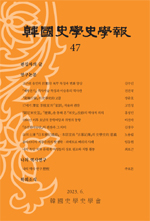학술논문
1894년 이후 호남의 동학여당과 의병의 동향
이용수 36
- 영문명
- The remaining forces of Donghak and the trend of righteous army in Honam since 1894: Focusing on the 『Hongjae diary』 of Ki Haeng-hyun, a Buan Confucian scholar
- 발행기관
- 한국사학사학회
- 저자명
- 이선아
- 간행물 정보
- 『한국사학사학보』제47권, 183~215쪽, 전체 33쪽
- 주제분류
- 인문학 > 역사학
- 파일형태
- 발행일자
- 2023.06.30
6,760원
구매일시로부터 72시간 이내에 다운로드 가능합니다.
이 학술논문 정보는 (주)교보문고와 각 발행기관 사이에 저작물 이용 계약이 체결된 것으로, 교보문고를 통해 제공되고 있습니다.

국문 초록
『홍재일기(鴻齋日記)』는 전라도 부안군 주산면[당시 남하면] 홍해마을에 거주하였던 기행현(奇幸鉉; 1843-?)이 1866년부터 1911년까지 쓴 일기이다. 기행현은 『홍재일기』에 동학농민혁명이 전개된 고부, 태인, 남원, 전주 등 인근에서 일어나는 사건과 그에 대한 소식과 소문에 대해 기록하였다. 그는 동학여당(東學餘黨)이라고 지칭된 영학당(英學黨)과 화적(火賊)의 동향에 대해서도 기록하였다. 당시 정부에서는 영학당을 ‘동비(東匪)의 여얼(餘孼)’로 간주하였고, 의병도 동학과 같은 무리로 탄압하였으며 활빈당(活貧黨)과 수적(水賊) 등도 동학에 뿌리를 두었다고 생각하였다. 한편 동학여당에 대한 탄압이 지속되는 가운데, 일진회(一進會)가 조직되었고 부안에서도 일진회원으로 활동하는 사람이 등장하였다. 일진회는 지방의 관권에 개입하고 마을의 행정에도 관여하였다. 일진회원이라고 위세를 부리며 무리를 일으키는 사례도 있었다. 이러한 일진회의 위세는 러일전쟁이 일본의 승리로 끝나고 을사늑약이 체결되면서 더욱 강화되었다. 을사늑약 체결 이후 호남에서도 의병이 일어났다. 의병의 투쟁은 1907년 고종의 퇴위와 한국군 해산 등으로 더욱 강경해졌다. 동학농민혁명 이후 동학여당은 을사늑약과 정미조약 등 일본의 국권 침탈이 심화되는 상황에서 왜병과 접전(接戰)하면서 의병으로 전환되어 일제의 침략에 맞서 항전(抗戰)하는 대열에 합류하였다.
영문 초록
『Hongjae Diary(1866-1911)』 is a diary written by Ki Haeng-hyeon(1843-?) who lived in Buan-gun, Jeolla-do. Ki haeng-hyeon recorded events, news, and rumors in Gobu, Taein, Namwon, and Jeonju, where the Donghak Peasant Revolution took place. He also recorded the trends of Yeonghakdang and Hwajeok, which were called the remaining forces of Donghak. The central government recognized it as a group like Donghak and the righteous army and suppressed the righteous army commander. In this way, Donghak-gun which was disbanded after the Donghak Peasant Revolution, continued its momentum as the remaining forces of Donghak, such as Yeonghakdang, Hwajeok, and Sujeok. Amid the continued suppression of the Donghak, the Iljinhoe was organized, and a person working as a Iljinhoe appeared in Buan. Iljinhoe intervened in local government authority and was also involved in the administration of village. This power of Iljinhoe was further strengthened when the Russo-Japanese War ended with Japan's victory and Japan-Korea Treaty of 1905 was signed. Since the signing of the Japan-Korea Treaty of 1905, righteous army has occurred in all parts of the country. The activities of the righteous army became stronger with the abdication of Gojong and the dissolution of the Korean army in 1907. Ki Haeng-hyeon recorded the size of the righteous army identified through newspapers, the murder or expulsion of local officials. After the Donghak Peasant Revolution, Donghak-gun in Honam returned to Yeonghakdang and continued its momentum as the remaining forces of Donghak including Hwajeok, and Sujeok. In an era when the sovereignty of the country was lost, Donghak's remaining forces were converted to righteous army by fighting against the Japanese army. Donghak-gun, suppressed by the Japanese military, rejoined the ranks of resistance against Japanese invasion as a righteous army.
목차
I. 머리말
II. 을미사변 이후 동학여당의 동향
III. 일본의 국권 침탈과 호남의병의 양상
IV. 맺음말
키워드
해당간행물 수록 논문
참고문헌
교보eBook 첫 방문을 환영 합니다!

신규가입 혜택 지급이 완료 되었습니다.
바로 사용 가능한 교보e캐시 1,000원 (유효기간 7일)
지금 바로 교보eBook의 다양한 콘텐츠를 이용해 보세요!





